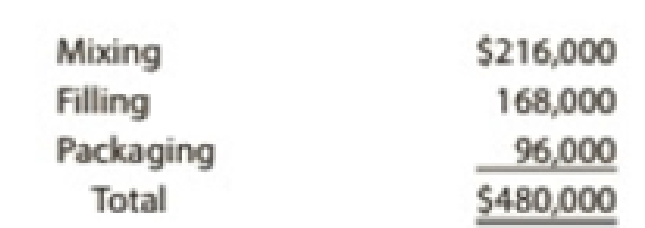
Concept explainers
Process activity analysis
The Brite Beverage Company bottles soft drinks into aluminum cans. The manufacturing process consists of three activities:
- 1. Mixing: water, sugar, and beverage concentrate are mixed.
- 2. Filling: mixed beverage is filled into 12-oz. cans.
- 3. Packaging: properly filled cans are boxed into cardboard “fridge packs.”
The activity costs associated with these activities for the period are as follows:

The activity costs do not include materials costs, which are ignored for this analysis. Each can is expected to contain 12 ounces of beverage. Thus, after being filled, each can is automatically weighed. If a can is too light, it is rejected, or “kicked,” from the filling line prior to being packaged. The primary cause of kicks is heat expansion. With heat expansion, the beverage overflows during filling, resulting in underweight cans.
This process begins by mixing and filling 6,300,000 cans during the period, of which only 6,000,000 cans are actually packaged. Three hundred thousand cans are rejected due to underweight kicks.
A process improvement team has determined that cooling the cans prior to filling them will reduce the amount of overflows due to expansion. After this improvement, the number of kicks is expected to decline from 300,000 cans to 63,000 cans, thus increasing the number of filled cans to 6,237,000 [6,000,000 + (300,000 − 63,000)].
- A. Determine the total activity cost per packaged can under present operations.
- B. Determine the amount of increased packaging activity costs from the expected improvements.
- C. Determine the expected total activity cost per packaged can after improvements. Round to three decimal places.
Trending nowThis is a popular solution!

Chapter 27 Solutions
Financial And Managerial Accounting
- ?arrow_forwardFinancial accounting questionarrow_forwardChoji Industries had total assets of $800,000 and total liabilities of $500,000 at the beginning of the year. During the year, total assets decreased by $120,000, and stockholders' equity increased by $90,000. What is the amount of total liabilities at the end of the year?arrow_forward
- A manufacturing company uses the weighted-average method for inventory costing. At the end of the period, 20,500 units were in the ending Work-in-Process inventory and are 100% complete for materials and 68% complete for conversion. The equivalent costs per unit are materials $3.10 and conversion $2.45. Compute the cost that would be assigned to the ending Work-in-Process inventory for the period. Answer thisarrow_forwardSolve this financial accounting problemarrow_forwardThen the decrease sales??arrow_forward
 Managerial AccountingAccountingISBN:9781337912020Author:Carl Warren, Ph.d. Cma William B. TaylerPublisher:South-Western College Pub
Managerial AccountingAccountingISBN:9781337912020Author:Carl Warren, Ph.d. Cma William B. TaylerPublisher:South-Western College Pub Financial And Managerial AccountingAccountingISBN:9781337902663Author:WARREN, Carl S.Publisher:Cengage Learning,
Financial And Managerial AccountingAccountingISBN:9781337902663Author:WARREN, Carl S.Publisher:Cengage Learning, Cornerstones of Cost Management (Cornerstones Ser...AccountingISBN:9781305970663Author:Don R. Hansen, Maryanne M. MowenPublisher:Cengage Learning
Cornerstones of Cost Management (Cornerstones Ser...AccountingISBN:9781305970663Author:Don R. Hansen, Maryanne M. MowenPublisher:Cengage Learning Managerial Accounting: The Cornerstone of Busines...AccountingISBN:9781337115773Author:Maryanne M. Mowen, Don R. Hansen, Dan L. HeitgerPublisher:Cengage Learning
Managerial Accounting: The Cornerstone of Busines...AccountingISBN:9781337115773Author:Maryanne M. Mowen, Don R. Hansen, Dan L. HeitgerPublisher:Cengage Learning



